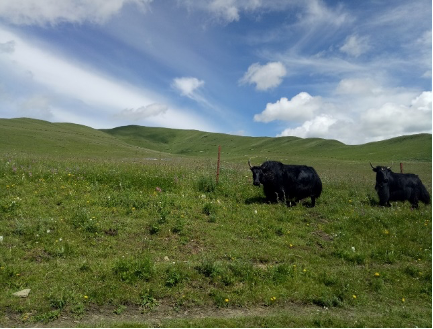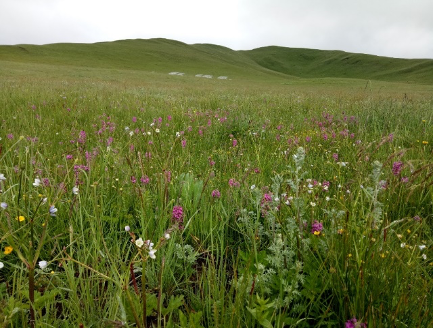Pollination in alpine meadows benefits from seasonal exclusion of livestock on the Tibetan Plateau
- ConScience

- Sep 17, 2021
- 2 min read
Updated: Sep 1, 2022
By Erliang Gao
Erliang Gao is a joint PhD student co-supervised by Dr. Christopher Kaiser-Bunbury (University of Exeter) and Dr. Zhigang Zhao (Lanzhou University) and funded by the Chinese Scholarship Council. Erliang’s research interests include pollination ecology, ecological networks and community ecology. Erliang has worked on the Tibetan Plateau over past several years for the conservation and restoration of the alpine grassland ecosystem.
In our recent paper in Frontiers in Ecology and Evolution we show experimentally that exclusion of yak grazing during the growing season can effectively restore plant-pollinator interactions and pollination function.
Grazed (left) and ungrazed (right) meadows at the Research Station of alpine meadow and wetland ecosystems of Lanzhou University (3530 m asl). Yaks are the main livestock in this region.
The alpine meadow ecosystem, as the main ecosystem type on the Tibetan Plateau, serves as vital rangeland for Tibetan sheep and yak. Besides livestock production, alpine meadow also provides a variety of ecosystem services, including carbon storage and climate regulation. However, alpine meadows have suffered severe degradation due to overgrazing and climate changes. Alpine meadow degradation has reduced grassland productivity, species diversity, and pollinator abundance, thereby contributing to loss of biodiversity and ecosystem function, with negative consequences for human wellbeing, such as reducing livestock production and income.
To restore and conserve alpine meadows, Tibetan herders have followed government guidelines since the early 2000s and adjusted grazing regimes: in severely degraded areas, grasslands were ungrazed during the growing season, but grazed over winter (generally from October to March). In ungrazed areas, the vegetation recovered well and species diversity increased, yet the knock-on effects for pollinators were largely unknown. This knowledge gap needs to be filled because most flowering plants rely on pollinators for reproduction and interactions between plants and pollinators are crucial to maintain biodiversity.
We surveyed three ungrazed meadows and adjacent grazed meadows for two consecutive years. Using an experimental approach, we found that meadows left ungrazed over summer produced a greater number of flowers and attracted more pollinator species and visits. Metrics that describe the entire community of plants and their pollinators indicated the communities were more robust to secondary extinction, i.e. the probability of a plant species becoming extinct because of the disappearance of a pollinator was lower in ‘restored’ meadows. It was encouraging to see that increased pollinator visitation resulted in higher plant reproduction, which suggests that the quality of pollination was positively affected by the grazing exclusion.
We concluded that although intensive grazing in fragile alpine ecosystems is contributing to the decline in biodiversity on Tibetan meadows, the impact can be reversed by reducing grazing pressure through seasonal exclusion of grazing animals. Our research suggests that seasonal grazing exclusion is an effective and sustainable restoration approach as it restores not only community structure but also ecosystem function.
Article information: Front. Ecol. Evol., 13 April 2021 | https://doi.org/10.3389/fevo.2021.632961








